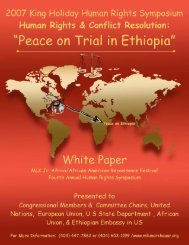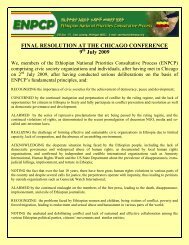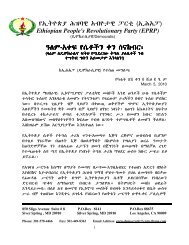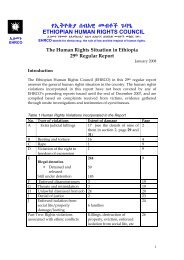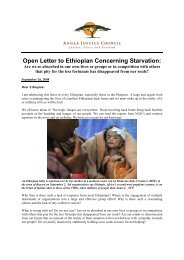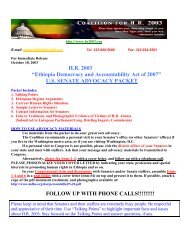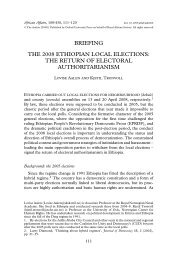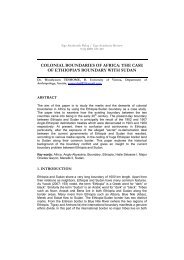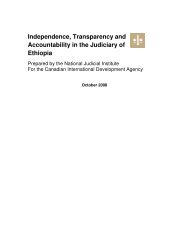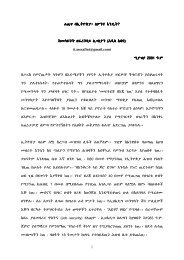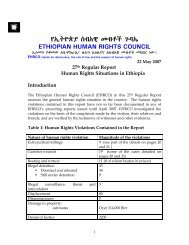Constitutionalism in the Horn of Africa - Abbay Media, Ethiopian News
Constitutionalism in the Horn of Africa - Abbay Media, Ethiopian News
Constitutionalism in the Horn of Africa - Abbay Media, Ethiopian News
You also want an ePaper? Increase the reach of your titles
YUMPU automatically turns print PDFs into web optimized ePapers that Google loves.
DIIPERDevelopment, Innovation andInternational PoliticalEconomy ResearchAalborg UniversityFibigerstraede 2-8aDK-9220 Aalborg EastPhone: +45 9940 9813Fax: +45 9635 0044Mail: diiper@lists.ihis.aau.dk<strong>Constitutionalism</strong> <strong>in</strong> <strong>the</strong> <strong>Horn</strong><strong>of</strong> <strong>Africa</strong>: Lesson from <strong>the</strong> newconstitution <strong>of</strong> EthiopiaBerhanu Gutema BalchaDIIPER RESEARCH SERIESWORKING PAPER NO. 15ISSN: 1902-8679
© 2009 Berhanu Gutema Balcha<strong>Constitutionalism</strong> <strong>in</strong> <strong>the</strong> <strong>Horn</strong> <strong>of</strong> <strong>Africa</strong>: Lesson from <strong>the</strong> new constitution <strong>of</strong>EthiopiaDevelopment, Innovation and International Political Economy Research (DIIPER)Aalborg UniversityDenmarkDIIPER Research SeriesWork<strong>in</strong>g Paper No. 15ISSN 1902-8679Published byDIIPER & Department <strong>of</strong> History, International and Social StudiesAalborg UniversityDistributionDownload as PDF onhttp://www.diiper.ihis.aau.dk/research/3397011Lay-out and word process<strong>in</strong>gCirkel<strong>in</strong>e KappelThe SecretariatDevelopment, Innovation and International Political Economy ResearchFibigerstraede 2, room 99Aalborg UniversityDK-9220 Aalborg EastDenmarkTel. + 45 9940 8310Fax. + 45 9635 0044E-mail: diiper@lists.ihis.aau.dkHomepage: http://www.diiper.ihis.dk/
<strong>Constitutionalism</strong> <strong>in</strong> <strong>the</strong> <strong>Horn</strong> <strong>of</strong> <strong>Africa</strong>: Lesson from <strong>the</strong> newconstitution <strong>of</strong> Ethiopia 1Berhanu Gutema Balcha 21. IntroductionA New Constitution was ratified <strong>in</strong> December 1994 and adopted <strong>in</strong> May 1995 and put<strong>in</strong>to effect on 22 August 1995. The constitution <strong>of</strong>ficially endorses <strong>the</strong> ethnic federalrestructur<strong>in</strong>g <strong>in</strong> <strong>the</strong> country by declar<strong>in</strong>g <strong>the</strong> establishment <strong>of</strong> a federal and democraticstructure and establishment <strong>of</strong> n<strong>in</strong>e regional states by declar<strong>in</strong>g that sovereign powershould reside with <strong>the</strong> ‘nations, nationalities and peoples’ <strong>of</strong> Ethiopia (Article 1, 8, and47, <strong>the</strong> 1994 <strong>Ethiopian</strong> Constitution).The constitution <strong>in</strong>cluded crucial human and democratic rights provisions based on <strong>the</strong>Universal Declaration <strong>of</strong> Human Rights <strong>of</strong> <strong>the</strong> United Nations, which declared forunconditional respect <strong>of</strong> human rights. Notably, it claimed to have <strong>the</strong> beg<strong>in</strong>n<strong>in</strong>g <strong>of</strong> anew chapter <strong>in</strong> <strong>Ethiopian</strong> history <strong>in</strong> which ‘each nation, nationality and people have <strong>the</strong>right to adm<strong>in</strong>ister its own affairs with<strong>in</strong> its own def<strong>in</strong>ed territory and effectivelyparticipate <strong>in</strong> <strong>the</strong> central government on <strong>the</strong> basis <strong>of</strong> freedom, and fair and properrepresentation’. Although <strong>the</strong> formal recognition <strong>of</strong> ethnic diversity and equal treatment<strong>of</strong> all ethnic groups had become <strong>the</strong> core pr<strong>in</strong>ciple <strong>of</strong> <strong>the</strong> constitution, it rema<strong>in</strong>s to beseen how far this constitutional rhetoric is really successful <strong>in</strong> transform<strong>in</strong>g <strong>the</strong><strong>Ethiopian</strong> state <strong>in</strong>to a workable federal model. Close exploration and exam<strong>in</strong>ation <strong>of</strong> <strong>the</strong>constitution below will <strong>in</strong>dicate whe<strong>the</strong>r <strong>the</strong> federal arrangement <strong>in</strong> Ethiopia has beenfounded on a genu<strong>in</strong>e covenant or agreement.12This paper was presented at <strong>the</strong> <strong>Horn</strong> <strong>of</strong> <strong>Africa</strong> Workshop: What is <strong>the</strong> Way out: Challenges <strong>in</strong>Overcom<strong>in</strong>g Governance Crises, Endemic Conflicts and Negative External Involvements <strong>in</strong> <strong>the</strong><strong>Horn</strong> <strong>of</strong> <strong>Africa</strong>? The workshop took place May 26, 2008 at Aalborg University and was hosted byDevelopment, Innovation and International Political Economy Research (DIIPER) <strong>in</strong> Collaborationwith Centre for Comparative Integration Studies (CCIS), Aalborg University.Berhanu Gutema Balcha holds a PhD on ”The Mak<strong>in</strong>g <strong>of</strong> <strong>the</strong> State <strong>in</strong> <strong>Africa</strong>: The Experiment <strong>of</strong>‘Ethnic-Federal’ Decentralisation <strong>in</strong> Ethiopia” from DIR – Research Center on Development andInternational Relations, Aalborg University.1
2. Constitutional distribution <strong>of</strong> powerThe constitution declares for <strong>the</strong> establishment <strong>of</strong> a parliamentarian system <strong>of</strong>governance that has a two-chamber parliament at <strong>the</strong> federal level, namely House <strong>of</strong>People Representative (HPR) and House <strong>of</strong> Federation (HF) (Article 45). HPR is <strong>the</strong>federal legislative body, which has <strong>the</strong> supreme authority. Its members are elected for aterm <strong>of</strong> five years by a system <strong>of</strong> a plurality <strong>of</strong> votes cast from each electoral district orconstituency that has 100,000 populations. It has about 547 seats and <strong>the</strong> constitution puta limit on <strong>the</strong> number <strong>of</strong> seats <strong>of</strong> <strong>the</strong> HPR not to exceed 550.The HPR is granted a full power <strong>of</strong> legislation <strong>in</strong> all matters assigned to <strong>the</strong> federaljurisdiction by <strong>the</strong> constitution (Article 55). The second chamber, which is called <strong>the</strong>House <strong>of</strong> Federation (HF), is composed <strong>of</strong> representatives <strong>of</strong> Nations, Nationalities andPeoples’ (Article 61). It can be simply called as a house <strong>of</strong> nationalities or house <strong>of</strong>ethnic groups. Accord<strong>in</strong>g to <strong>the</strong> constitution (Article 61) that: ‘Each Nation, Nationalityand People shall be represented <strong>in</strong> <strong>the</strong> House <strong>of</strong> <strong>the</strong> Federation by at least one member.Each Nation or Nationality shall be represented by one additional representative for eachone million <strong>of</strong> its population’.Constitutionally, <strong>the</strong> HF has <strong>the</strong> power to <strong>in</strong>terpret <strong>the</strong> Constitution and organize <strong>the</strong>council <strong>of</strong> constitutional <strong>in</strong>quiry (Article 62). O<strong>the</strong>r major powers and functions <strong>of</strong> <strong>the</strong>HF <strong>in</strong>clude, mak<strong>in</strong>g <strong>of</strong> decision on issues relat<strong>in</strong>g to <strong>the</strong> rights <strong>of</strong> Nations, Nationalitiesand Peoples to self-determ<strong>in</strong>ation, <strong>in</strong>clud<strong>in</strong>g <strong>the</strong> right to secession; promote <strong>the</strong> equality<strong>of</strong> <strong>the</strong> Peoples <strong>of</strong> Ethiopia enshr<strong>in</strong>ed <strong>in</strong> <strong>the</strong> Constitution and promote and consolidate<strong>the</strong>ir unity based on <strong>the</strong>ir mutual consent; make every effort to f<strong>in</strong>d solutions to disputesor misunderstand<strong>in</strong>gs that may arise between States; determ<strong>in</strong>e <strong>the</strong> division <strong>of</strong> revenuesderived from jo<strong>in</strong>t Federal and State tax sources and <strong>the</strong> subsidies that <strong>the</strong> FederalGovernment may provide to <strong>the</strong> States; determ<strong>in</strong>e Federal <strong>in</strong>tervention if any State, <strong>in</strong>violation <strong>of</strong> this Constitution, endangers <strong>the</strong> constitutional order (Article 62).Although <strong>the</strong> constitution allocates very vital powers and responsibilities to <strong>the</strong> HF, itsability to exercise its power has been impaired by <strong>the</strong> same constitution that permits <strong>the</strong>HF to establish permanent and ad hoc committees to exercise most <strong>of</strong> its power andfunctions and <strong>the</strong> constitution does not require <strong>the</strong> HF to have frequent sessions, ra<strong>the</strong>r itrequires <strong>the</strong> HF to have at least two sessions annually (Article 67). Thus, <strong>the</strong> HF isexercis<strong>in</strong>g most <strong>of</strong> its power and functions through by few <strong>in</strong>dividuals work<strong>in</strong>g <strong>in</strong> <strong>the</strong>committees without mak<strong>in</strong>g frequent consultation and decision <strong>of</strong> <strong>the</strong> whole member <strong>of</strong><strong>the</strong> HF. The weak role <strong>of</strong> <strong>the</strong> HF has created an opportunity for concentration <strong>of</strong> poweron <strong>the</strong> w<strong>in</strong>ner party <strong>in</strong> <strong>the</strong> federal government.2
secession, whereas mak<strong>in</strong>g <strong>the</strong> HF highly dependent on <strong>the</strong> states’ councils and for thatmatter, as argued above, mak<strong>in</strong>g it dependent on <strong>the</strong> executive bodies at <strong>the</strong> regional and<strong>the</strong> federal government levels. This phenomenon deprives <strong>the</strong> <strong>Ethiopian</strong> federal system<strong>the</strong> exclusive hallmark <strong>of</strong> a federal system, which is a division or separation <strong>of</strong> power(K<strong>in</strong>g 1982: 94). This may be a deliberate attempt by <strong>the</strong> framers <strong>of</strong> <strong>the</strong> constitution wh<strong>of</strong>oresee <strong>the</strong> difficulties <strong>in</strong> handl<strong>in</strong>g and satisfy<strong>in</strong>g various self-seek<strong>in</strong>g and prov<strong>in</strong>cialdemands <strong>of</strong> ethnic groups. However, <strong>in</strong> <strong>the</strong> absence <strong>of</strong> check and balance mechanisms,<strong>the</strong> political process could be easily abused by <strong>the</strong> rul<strong>in</strong>g power to protect its own selfseek<strong>in</strong>gand prov<strong>in</strong>cial <strong>in</strong>terest. As Horowitz argues that constitutional designs haveeffects on <strong>the</strong> distribution <strong>of</strong> power, and those who ga<strong>in</strong> power as a result may wish toalter <strong>the</strong> design to favor <strong>the</strong>mselves (Horowitz 2002: 33).The constitution states that <strong>the</strong> members <strong>of</strong> <strong>the</strong> HF are ei<strong>the</strong>r elected by <strong>the</strong> statecouncils or elected by <strong>the</strong> people directly, however <strong>in</strong> <strong>the</strong> actual experience it has been<strong>the</strong> states’ council that appo<strong>in</strong>ts <strong>the</strong>ir respective members <strong>in</strong> <strong>the</strong> HF. This means that <strong>the</strong>majority party <strong>in</strong> <strong>the</strong> states’ councils has also a power to <strong>in</strong>fluence <strong>the</strong> HF <strong>in</strong> <strong>the</strong> federalgovernment. This also shows <strong>the</strong> level <strong>of</strong> power concentration <strong>in</strong> <strong>the</strong> hands <strong>of</strong> a s<strong>in</strong>glew<strong>in</strong>ner party. In <strong>the</strong> current one-party dom<strong>in</strong>ant political process <strong>in</strong> Ethiopia, <strong>the</strong> EPRDFhas used such constitutional loophole for its advantage to impose its power and also toprotect its parochial <strong>in</strong>terest <strong>in</strong> all level <strong>of</strong> <strong>the</strong> federal and regional power structures. The<strong>in</strong>tegrity <strong>of</strong> <strong>the</strong> constitutional design depends on <strong>the</strong> <strong>in</strong>tegrity <strong>of</strong> demarcat<strong>in</strong>g <strong>the</strong>boundary s<strong>in</strong>ce ‘<strong>the</strong> looser <strong>the</strong> design and <strong>the</strong> easier <strong>the</strong> adoption, <strong>the</strong> easier <strong>the</strong>alteration as well (Ibid. p. 32).The constitution grants equal powers and responsibilities to <strong>the</strong> various regional states asit states that ‘Member States <strong>of</strong> <strong>the</strong> Federal Democratic Republic <strong>of</strong> Ethiopia shall haveequal rights and powers’ (Article 47). This entails that <strong>the</strong> <strong>Ethiopian</strong> federal system isconstitutionally designed to be a symmetrical federal system. Each regional state hasstate council that function as <strong>the</strong> legislative body <strong>of</strong> <strong>the</strong> regional government. Apresident who is elected by <strong>the</strong> state council leads an executive power <strong>in</strong> all <strong>of</strong> <strong>the</strong>regional states. The Constitution (Article 52) reserves all powers to <strong>the</strong> states exceptthose given expressly to <strong>the</strong> federal government alone, or concurrently to <strong>the</strong> federal andregional governments. Some <strong>of</strong> <strong>the</strong> major powers and functions entrusted to <strong>the</strong> regionalstates <strong>in</strong>clude:To establish a State adm<strong>in</strong>istration that best advances self-government, a democraticorder based on <strong>the</strong> rule <strong>of</strong> law; to protect and defend <strong>the</strong> Federal Constitution;• To enact and execute <strong>the</strong> state constitution and o<strong>the</strong>r laws;4
• To formulate and execute economic, social and development policies, strategies andplans <strong>of</strong> <strong>the</strong> State;• To adm<strong>in</strong>ister land and o<strong>the</strong>r natural resources <strong>in</strong> accordance with Federal laws;• To levy and collect taxes and duties on revenue sources reserved to <strong>the</strong> States and todraw up and adm<strong>in</strong>ister <strong>the</strong> State budget;• To enact and enforce laws on <strong>the</strong> State civil service and <strong>the</strong>ir condition <strong>of</strong> work; <strong>in</strong> <strong>the</strong>implementation <strong>of</strong> this responsibility it shall ensure that educational; tra<strong>in</strong><strong>in</strong>g andexperience requirements for any job, title or position approximate national standards;• To establish and adm<strong>in</strong>ister a state police force, and to ma<strong>in</strong>ta<strong>in</strong> public order andpeace with<strong>in</strong> <strong>the</strong> state.Constitutionally, it appears very difficult to reduce or alter <strong>the</strong> power and function <strong>of</strong>any <strong>of</strong> <strong>the</strong> regional states unless <strong>the</strong> council <strong>of</strong> <strong>the</strong> concerned regional state concedes to<strong>the</strong> alteration <strong>of</strong> its power, which is <strong>of</strong> course a very unusual scenario. The constitutionputs a strong protection aga<strong>in</strong>st any easy alternation or amendment <strong>of</strong> <strong>the</strong> constitution.Any proposal for constitutional amendment should be supported by a two-thirdsmajority vote <strong>of</strong> a jo<strong>in</strong>t session <strong>of</strong> <strong>the</strong> HPR and <strong>the</strong> HF, and should also be approved bya two-thirds <strong>of</strong> <strong>the</strong> Councils <strong>of</strong> <strong>the</strong> member States <strong>of</strong> <strong>the</strong> Federation by majority votes(Article 105). More strictly, amendment to Chapter three <strong>of</strong> <strong>the</strong> Constitution thatconta<strong>in</strong>s human rights and democratic rights <strong>in</strong>clud<strong>in</strong>g <strong>the</strong> rights <strong>of</strong> nations,nationalities, and peoples and, <strong>the</strong> provision which deals with amendment <strong>of</strong> <strong>the</strong>constitution, require <strong>the</strong> approval <strong>of</strong> all state councils by a majority vote and <strong>the</strong>approval <strong>of</strong> <strong>the</strong> HPR and HF by a two- thirds majority vote. In this regard, <strong>the</strong>constitutional approach <strong>in</strong> Ethiopia is <strong>in</strong> accordance with <strong>the</strong> basic federal pr<strong>in</strong>ciple thatrequires <strong>the</strong> consent <strong>of</strong> a very bigger majority group <strong>in</strong> constitutional alteration (K<strong>in</strong>g1982; Elazar 1995; Watts 2000).None<strong>the</strong>less, it is one th<strong>in</strong>g to put <strong>the</strong> provisions <strong>in</strong> <strong>the</strong> constitution and ano<strong>the</strong>r togenu<strong>in</strong>ely pursue <strong>the</strong>m. As Leenco anticipated that <strong>the</strong> TPLF can afford to be quitegenerous on paper s<strong>in</strong>ce it will not be bound by those aspects <strong>of</strong> any legislation thatappear to restra<strong>in</strong> its freedom to act with impunity, (Leenco 1999: 11). Despite a gestureto devolve power to <strong>the</strong> regional states and local self-government units, <strong>the</strong> process hasbeen marked by a centralization <strong>of</strong> power at <strong>the</strong> center that was overwhelm<strong>in</strong>glydom<strong>in</strong>ated by <strong>the</strong> TPLF (Young 1998: 321; Clapham 2002: 26; Merera 2003: 121). Dueto <strong>the</strong> concentration <strong>of</strong> power on <strong>the</strong> TPLF/EPRDF, <strong>the</strong> exercise <strong>of</strong> power from <strong>the</strong>federal government to <strong>the</strong> woreda and kebele adm<strong>in</strong>istrative structures has been flow<strong>in</strong>gthrough <strong>the</strong> centralized TPLF/ EPRDF’s party network, thus <strong>the</strong> declarations <strong>in</strong> <strong>the</strong>constitution do not reflect <strong>the</strong> actual power exercise <strong>in</strong> Ethiopia’s federal system.5
Moreover, <strong>the</strong> higher centripetal character <strong>of</strong> <strong>the</strong> federal system <strong>in</strong> Ethiopia could alsobe gleaned from <strong>the</strong> concentration <strong>of</strong> policymak<strong>in</strong>g power on <strong>the</strong> federal government,<strong>the</strong> concentration <strong>of</strong> f<strong>in</strong>ancial power and budget allocation responsibility on <strong>the</strong> federalgovernment and a weak capacity <strong>of</strong> <strong>the</strong> regional states <strong>in</strong> terms <strong>of</strong> skilled manpower(Vaughan and Tronvoll 2003: 12). Abb<strong>in</strong>k (1998:167) also claims that <strong>the</strong> actualdivision <strong>of</strong> powers between member states and federal government <strong>in</strong> Ethiopia is ‘notfederal enough’ because <strong>the</strong> states do not have any role <strong>in</strong> debat<strong>in</strong>g <strong>the</strong> policies and <strong>in</strong>propos<strong>in</strong>g legislation formulated at <strong>the</strong> federal level. He justifies this claim by po<strong>in</strong>t<strong>in</strong>gat <strong>the</strong> fact that o<strong>the</strong>r federal systems, such as <strong>the</strong> German, Canadian, Nigerian andMexican, have given more power <strong>of</strong> this k<strong>in</strong>d to <strong>the</strong> member states. Moreover, <strong>in</strong> issuesconcern<strong>in</strong>g constitutional disputes, <strong>the</strong> regional states have a very <strong>in</strong>significantconstitutional role to challenge decisions made by <strong>the</strong> HF and Council <strong>of</strong> ConstitutionalInquiry, which are structured with<strong>in</strong> <strong>the</strong> jurisdiction <strong>of</strong> <strong>the</strong> federal government <strong>in</strong> which<strong>the</strong> federal executive particularly <strong>the</strong> PM has a tremendous power to <strong>in</strong>fluence <strong>the</strong>irdeliberation and operation.3. Article 39: The right to establish self-government or <strong>the</strong> right to secedeArticle 39 declares an unconditional right to self-determ<strong>in</strong>ation, <strong>in</strong>clud<strong>in</strong>g <strong>the</strong> right tosecession <strong>of</strong> every nation, nationality and peoples <strong>in</strong> Ethiopia. Accord<strong>in</strong>g to <strong>the</strong>constitution, ‘nation, nationalities or people symbolizes ‘a group <strong>of</strong> people who have orshare large measure <strong>of</strong> a common culture or similar customs, mutual <strong>in</strong>telligibility <strong>of</strong>language, belief <strong>in</strong> a common or related identities, a common psychological make-up,and who <strong>in</strong>habit an identifiable, predom<strong>in</strong>antly contiguous territory’ (Article 39, 5).Evidently, this contradicts <strong>the</strong> federal solution that aims to deter secession. Accord<strong>in</strong>gto Henze (1995: 35) that ‘<strong>the</strong> right to secede’ <strong>in</strong> Ethiopia constitution is narrowlyspecified without exhaustively elaborat<strong>in</strong>g various options <strong>of</strong> self-determ<strong>in</strong>ation thatcould be more logical, practicable and humble than <strong>the</strong> destructive and impracticable‘<strong>the</strong> right to secession’ cliché. Henze <strong>in</strong>dicates experience <strong>in</strong> Spa<strong>in</strong> <strong>in</strong> which autonomouscommunities are granted broader power <strong>of</strong> various magnitudes through a process <strong>of</strong>deliberation and barga<strong>in</strong><strong>in</strong>g <strong>in</strong> order to avoid <strong>the</strong> possibility <strong>of</strong> separation or secession.For Duchacek (1987: 207), <strong>the</strong> <strong>in</strong>clusion <strong>of</strong> <strong>the</strong> rights for secession <strong>in</strong> <strong>the</strong> federal barga<strong>in</strong>would facilitate <strong>the</strong> dissolution <strong>of</strong> <strong>the</strong> federal framework by encourag<strong>in</strong>g centrifugaltendencies, but <strong>the</strong> right <strong>of</strong> secession would go along more with a confederalarrangement <strong>in</strong> which parts are completely autonomous to leave <strong>the</strong> confederation withvery less difficulties and <strong>in</strong>significant harm to each o<strong>the</strong>r.6
The <strong>in</strong>sertion <strong>of</strong> <strong>the</strong> right for secession promises <strong>in</strong> <strong>the</strong> constitution may be clichéd from<strong>the</strong> USSR constitution that put <strong>the</strong> same right <strong>in</strong> <strong>the</strong> constitution but without anypracticability after <strong>the</strong> <strong>in</strong>dependence <strong>of</strong> F<strong>in</strong>land. At <strong>the</strong> dissolution <strong>of</strong> <strong>the</strong> USSR <strong>in</strong> 1991,<strong>the</strong> Russian federation emerged with a constitution <strong>of</strong> 1992 that allowed <strong>the</strong> right tosecede as a heir <strong>of</strong> <strong>the</strong> USSR, but <strong>the</strong> 1993 constitution scrapped <strong>the</strong> right to secede andopted for a process <strong>of</strong> asymmetrical and separate arrangement with every ethnic territoryfor negotiated power shar<strong>in</strong>g arrangements <strong>in</strong> order to deter <strong>the</strong> destructive burden <strong>of</strong>secessionism (Smith 2000). Many federal arrangements such as Canada andSwitzerland have embarked on grant<strong>in</strong>g feasible and fair broader local autonomyarrangements <strong>in</strong> order to discourage centrifugal tendencies. In <strong>the</strong> contrary, <strong>the</strong>Ethiopia’s constitutional pledges for secession; it puts a very audacious promise for ‘aright to secede’, but <strong>in</strong> reality <strong>the</strong> power holders are do<strong>in</strong>g very little to promote genu<strong>in</strong>eand feasible self-adm<strong>in</strong>istrative structures that would discourage a po<strong>in</strong>ter to <strong>the</strong>constitutional promise <strong>of</strong> secessionists’ bonfire. Ra<strong>the</strong>r, <strong>the</strong> <strong>Ethiopian</strong> federal experiencematches <strong>the</strong> ex-Soviet Union constitution that gave copious promises <strong>of</strong> selfdeterm<strong>in</strong>ation<strong>in</strong>clud<strong>in</strong>g <strong>in</strong>dependence for its ethnic republics but responded withruthless force when <strong>the</strong> rights were requested. To some extent, <strong>the</strong> same may be true <strong>in</strong>Ethiopia’s federal constitution, which is rich and overflow<strong>in</strong>g <strong>in</strong> freedom vocabulariesbut <strong>the</strong> actual performance is very far and opposite to <strong>the</strong> declarations. But <strong>the</strong> dangercould be very great <strong>in</strong> situation which <strong>of</strong>ficial pronouncement provokes and makescognizant parochial ethnic consciousness by reckless advertisement <strong>of</strong> <strong>the</strong> right tosecede, whereas <strong>of</strong>ficial actions are go<strong>in</strong>g <strong>in</strong> opposite and extreme directions <strong>of</strong>subjugation and curtailment <strong>of</strong> ord<strong>in</strong>ary rights and freedoms which <strong>of</strong> course re<strong>in</strong>forceand justify <strong>the</strong> demand for secession.Moreover, unfulfilled flashy and celebrated promises could create a strong adversereaction than discreetly and slightly presented ones s<strong>in</strong>ce undelivered promise maygenerate more powerful resentment than <strong>the</strong> non-promised ones. In situation where <strong>the</strong>power and <strong>the</strong> resource <strong>of</strong> <strong>the</strong> regional governments are subord<strong>in</strong>ate and dependent to<strong>the</strong> federal government at <strong>the</strong> center, <strong>the</strong> right to secede rhetoric could simply provide an<strong>in</strong>centive and justification to demand for secession. The regional governments <strong>in</strong>Ethiopia’s federal arrangement are highly dependent on <strong>the</strong> federal government; <strong>the</strong>yoperate <strong>in</strong> a manner that resembles a centralized adm<strong>in</strong>istration. The federalgovernment has a supreme power to decide on land and natural resources, it appropriateshuge tax bases, and it owns most <strong>of</strong> <strong>the</strong> nation’s <strong>in</strong>dustrial establishments. Besides,many <strong>of</strong> <strong>the</strong> ethnic groups are not exercis<strong>in</strong>g most <strong>of</strong> <strong>the</strong>ir rights listed <strong>in</strong> article 39,whereas a few are enjoy<strong>in</strong>g more than what <strong>the</strong>y actually deserve. Therefore, with such7
sorry milieu that breeds and exacerbates resentments, <strong>the</strong> right to secede cliché canbecome a recipe for disaster.Paradoxically, <strong>in</strong> <strong>Ethiopian</strong>, <strong>the</strong> rul<strong>in</strong>g group, which is dom<strong>in</strong>ated by a m<strong>in</strong>ority ethnicgroup from an impoverished region, has an unfair control over politics and economicsnationwide. At <strong>the</strong> same time, <strong>the</strong> same rul<strong>in</strong>g group promises <strong>the</strong> right to secede for <strong>the</strong>various ethnic groups who are relatively better endowed with resources. However, itdenies an au<strong>the</strong>ntic representation <strong>of</strong> <strong>the</strong>se ethnic groups. Instead, it uses surrogategroups and elites to maneuver and control ethnic groups. It is, however, becom<strong>in</strong>g verydifficult to susta<strong>in</strong> <strong>the</strong> proxy system for long <strong>in</strong> an efficient and credible manner. As it isaccounted that many <strong>of</strong> proxy <strong>of</strong>ficials ‘tend to be undiscipl<strong>in</strong>ed and corrupt, whichoccasionally resulted <strong>in</strong> massive dismissal and demotions’ (Merera 2003: 141).Fur<strong>the</strong>rmore, <strong>the</strong>re is a procedural confusion regard<strong>in</strong>g <strong>the</strong> constitutional provision thatallows <strong>the</strong> right to every ethnic group to establish <strong>in</strong>stitutions <strong>of</strong> government <strong>in</strong> <strong>the</strong>territory that it <strong>in</strong>habits and <strong>the</strong> right to establish, at any time, <strong>the</strong>ir own regional state.The <strong>in</strong>sertion <strong>of</strong> very ambiguous and complex procedures would make <strong>the</strong> rightmean<strong>in</strong>gless and <strong>the</strong> <strong>in</strong>tention <strong>in</strong>s<strong>in</strong>cere. The constitution states that <strong>the</strong> demand forstatehood should be approved by a two-thirds majority <strong>of</strong> <strong>the</strong> members <strong>of</strong> <strong>the</strong> Council <strong>of</strong><strong>the</strong> Nation, Nationality or People concerned, and it should be supported by a majorityvote <strong>in</strong> <strong>the</strong> referendum (Article 47). But <strong>in</strong> majority <strong>of</strong> cases, except <strong>in</strong> SNNP region’sfew ethnic groups (which have zonal council for <strong>the</strong>ir ethnic constituency), most <strong>of</strong> <strong>the</strong>ethnic groups do not have <strong>the</strong>ir own separate councils, paradoxically it is only those whohave been allowed to have <strong>the</strong>ir own self-adm<strong>in</strong>istrative constituency that have acouncil, but those ethnic groups (or ‘nations, nationalities and people’ as constitutionallynamed) without self-adm<strong>in</strong>istrative constituency do not have a council that supposed toapprove <strong>the</strong>ir demand for self-adm<strong>in</strong>istration constituency. For example, <strong>in</strong>Benishangul-Gumuz regional states a demand by <strong>the</strong> Benishangul (or Berta) elite tohave <strong>the</strong>ir own council was not enterta<strong>in</strong>ed for political discussion ei<strong>the</strong>r <strong>in</strong> <strong>the</strong> regionalcouncil or <strong>in</strong> <strong>the</strong> HF. The Benishangul people did not have <strong>the</strong>ir own council to approve<strong>the</strong> demand until 2003 and <strong>the</strong> state council, which was established by <strong>the</strong> five ethnicgroups (<strong>the</strong> Benishangul people have only 28 out <strong>of</strong> 80 seats), rejected <strong>the</strong>ir demand.This created a stra<strong>in</strong>ed relationship between <strong>the</strong> Benishangul elite and <strong>the</strong> Gumuz elitethat severely thwarted <strong>the</strong> operation <strong>of</strong> <strong>the</strong> regional state and also <strong>the</strong> hostility has beendeepen<strong>in</strong>g not only between <strong>the</strong> political elite’s <strong>of</strong> <strong>the</strong> two groups, but also among <strong>the</strong>ord<strong>in</strong>ary people <strong>of</strong> Benishangul and Gumuz (A member <strong>of</strong> zonal executive from Berta,Interviewee 8 2002: 10; An Elder from Berta, Interviewee 7 2002:18; (A regional<strong>of</strong>ficial, from Gumuz, 1, 2002: 1). A similar problem is occurr<strong>in</strong>g <strong>in</strong> <strong>the</strong> SNNP regional8
state, some <strong>of</strong> <strong>the</strong>se were <strong>the</strong> Sidama group has resented aga<strong>in</strong>st <strong>the</strong> SNNP’s councildecision to deny <strong>the</strong>m <strong>the</strong> ownership <strong>of</strong> Awassa city, <strong>the</strong> North Omo zone dis<strong>in</strong>tegrated<strong>in</strong> a bloody conflict due to <strong>the</strong> <strong>in</strong>ability <strong>of</strong> <strong>the</strong> four ethnic groups to agree <strong>in</strong> a s<strong>in</strong>glecouncil, <strong>the</strong> Gamo and G<strong>of</strong>a elites are cont<strong>in</strong>u<strong>in</strong>g <strong>the</strong>ir demand for a separate zonaladm<strong>in</strong>istration and <strong>the</strong>ir own separate council.Thus, <strong>the</strong> constitutional pledges for a right to self-adm<strong>in</strong>istration or secession is more <strong>of</strong>rhetoric than an achievable promise for many <strong>of</strong> <strong>the</strong> ethnic groups, as <strong>the</strong> long andcomplex procedures seem difficult to fulfill. In <strong>the</strong> future, however, it would be used forfacilitat<strong>in</strong>g and legitimiz<strong>in</strong>g an exit for a region that could build a capability to do so.Especially, <strong>the</strong>re is a widespread suspicion that, Tigray could be <strong>the</strong> first candidate toask for secession, if <strong>the</strong> hegemonic position <strong>of</strong> <strong>the</strong> Tigray elite <strong>in</strong> rul<strong>in</strong>g Ethiopia is <strong>in</strong>jeopardy. It may be for such purpose that article 39 that pledges <strong>the</strong> right <strong>of</strong> secession ishighly protected from any alteration and it needs <strong>the</strong> approval <strong>of</strong> all <strong>the</strong> regional statesfor its amendment, as it is declared <strong>in</strong> <strong>the</strong> constitution (Article 105) that article 39 whichis <strong>in</strong>cluded <strong>in</strong> ‘fundamental pr<strong>in</strong>ciples <strong>of</strong> <strong>the</strong> constitution’ can not be changed without<strong>the</strong> approval <strong>of</strong> all <strong>of</strong> <strong>the</strong> councils <strong>of</strong> <strong>the</strong> regional states, but to show a reveal<strong>in</strong>gcomparison, article 47 <strong>of</strong> <strong>the</strong> constitution that declares <strong>the</strong> establishment <strong>of</strong> <strong>the</strong> n<strong>in</strong>eregional states can be changed by <strong>the</strong> approval <strong>of</strong> a two-third <strong>of</strong> <strong>the</strong> councils <strong>of</strong> <strong>the</strong>regional states. Currently, however, <strong>the</strong> rhetoric <strong>of</strong> secession has produced two greatchallenges. First, it becomes an <strong>in</strong>centive for various ethnic groups to demand for aseparate self-adm<strong>in</strong>istrative constituency and separate regional state that has resulted forbloody conflict, displacement and ethnic hostility. Second, <strong>the</strong> rhetoric has generated abig voice that denounced <strong>the</strong> ‘secession right’ as a hidden motive to destroy <strong>the</strong><strong>Ethiopian</strong> state. However, such big denunciation has created confusion among manyethnic groups who are suspicious regard<strong>in</strong>g <strong>the</strong> motive beh<strong>in</strong>d <strong>the</strong> denunciation. And <strong>the</strong>rul<strong>in</strong>g group successfully maneuvered <strong>the</strong> denunciation as an opposition to <strong>the</strong> rights <strong>of</strong>ethnic groups for self-adm<strong>in</strong>istration, thus it restlessly worked for deepen<strong>in</strong>g <strong>the</strong>suspicion <strong>in</strong> order to capitalize political support from various ethnic groups for itshegemonic <strong>in</strong>terest.4. A flawed structure: a concentration <strong>of</strong> power on <strong>the</strong> chief executive <strong>of</strong> <strong>the</strong> federalgovernmentThe constitution (Article 45) states that Ethiopia should have a parliamentarian form <strong>of</strong>government <strong>in</strong> which <strong>the</strong> majority political party or a coalition <strong>of</strong> political parties thathas <strong>the</strong> greatest number <strong>of</strong> seats <strong>in</strong> <strong>the</strong> parliament, namely <strong>the</strong> HPR have a power toestablish a government. This constitutional design upholds a ‘w<strong>in</strong>ner takes all’ approach.9
This may be a very unsuitable political system for a multiethnic society that requires acoalition or power-shar<strong>in</strong>g arrangement. A federal system <strong>in</strong> a multiethnic society couldbe well suited to a negotiated and consociational-like arrangement that attempts toconstruct unity <strong>in</strong> diversity (Elazar 1987; Watts 1999; Agran<strong>of</strong>f 1998; Lijphart 2002) Asa result, a concentration <strong>of</strong> power on a s<strong>in</strong>gle w<strong>in</strong>ner could not satisfy <strong>the</strong> various<strong>in</strong>terests and needs <strong>of</strong> <strong>the</strong> numerous and diverse communities <strong>of</strong> multiethnic Ethiopia.Constitutionally, <strong>the</strong> w<strong>in</strong>ner part <strong>in</strong> <strong>the</strong> federal parliament (also similar <strong>in</strong> <strong>the</strong> regionalstates), has very extensive power and responsibilities, some <strong>of</strong> <strong>the</strong>se are:• Responsible for appo<strong>in</strong>t<strong>in</strong>g <strong>the</strong> prime m<strong>in</strong>ister who becomes a head <strong>of</strong> <strong>the</strong>government, leader <strong>of</strong> <strong>the</strong> cab<strong>in</strong>et and <strong>the</strong> commander-<strong>in</strong>-chief <strong>of</strong> <strong>the</strong> armed force.(Article 76).• Responsible for suggest<strong>in</strong>g nom<strong>in</strong>ees for m<strong>in</strong>isterial posts.• Supervision over <strong>the</strong> implementation <strong>of</strong> <strong>the</strong> country’s foreign policy.• Selects and submits for approval to <strong>the</strong> House <strong>of</strong> Peoples’ Representativesnom<strong>in</strong>ations for posts <strong>of</strong> Commissioners, <strong>the</strong> President and Vice-President <strong>of</strong> <strong>the</strong>Federal Supreme Court and <strong>the</strong> Auditor General.• Appo<strong>in</strong>ts high civilian <strong>of</strong>ficials <strong>of</strong> <strong>the</strong> Federal Government o<strong>the</strong>r than those referredabove.• Supervises <strong>the</strong> conduct and efficiency <strong>of</strong> <strong>the</strong> Federal adm<strong>in</strong>istration and takes suchcorrective measures as are necessary.The majority party <strong>in</strong> <strong>the</strong> legislative always assumes an exclusive control <strong>of</strong> <strong>the</strong>executive and judiciary branches <strong>of</strong> <strong>the</strong> federal as well as <strong>the</strong> regional governments andthus <strong>the</strong> w<strong>in</strong>n<strong>in</strong>g party assumes a total dom<strong>in</strong>ance <strong>of</strong> all branches <strong>of</strong> government, whichis very unsuitable for a feature <strong>of</strong> multiethnic society, because federal arrangements <strong>in</strong>multiethnic would require ei<strong>the</strong>r a coalition power centers or various centers <strong>of</strong> power.Many scholars, however, are uncerta<strong>in</strong> regard<strong>in</strong>g <strong>the</strong> efficiency and viability <strong>of</strong> an ethniccoalition arrangement or a proliferation <strong>of</strong> power centers <strong>in</strong> a polity (K<strong>in</strong>g 1982;Horowitz 1985, Elazar 1995). K<strong>in</strong>g, for example, argues that ‘a political system with<strong>in</strong>which each power is precisely checked by ano<strong>the</strong>r would not appear to be a feasiblesystem at all…a political system <strong>in</strong> which each social force is nicely blocked by someo<strong>the</strong>rs, seems to represent a non-system, not a system- more anarchy than a polity’ (K<strong>in</strong>g1982: 64). Horowitz also claims that ‘<strong>the</strong> assumption that elites <strong>in</strong> divided societies arelikely to be more tolerant <strong>of</strong> o<strong>the</strong>r ethnic groups or less <strong>in</strong>cl<strong>in</strong>ed to pursue advantage for<strong>the</strong>ir own group is extremely dubious’ (Horowitz 2002: 21). Thus, he claims thatcreat<strong>in</strong>g and susta<strong>in</strong><strong>in</strong>g coalition <strong>in</strong> divided societies is a very difficult task, but, <strong>of</strong>course, not impossible. In his empirical <strong>in</strong>vestigation, Horowitz, f<strong>in</strong>ds out that ‘educated10
elites <strong>in</strong> some countries to be less ethnocentric than <strong>the</strong>ir followers, <strong>in</strong> o<strong>the</strong>rs more, <strong>in</strong>some o<strong>the</strong>rs nei<strong>the</strong>r less nor more, and <strong>in</strong> still o<strong>the</strong>rs more with respect to some groupsand less or <strong>the</strong> same with respect to o<strong>the</strong>r groups’ (Ibid.). However, <strong>in</strong> multiethnicEthiopia <strong>in</strong> which autocratic rule is a norm, not an exception, it has been proved futile toquell ethnic or regional demands <strong>in</strong> centralized autocracy. The parliamentary system <strong>of</strong>governance based on <strong>the</strong> ‘w<strong>in</strong>ner takes all’ pr<strong>in</strong>ciple would not be a viable prototype toEthiopia that exhibits variations <strong>in</strong> political development, tradition <strong>of</strong> statehood, culturalassortments and ethnic and language configurations.Fur<strong>the</strong>rmore, <strong>the</strong> constitution gives a strong power to <strong>the</strong> executive, particularly to <strong>the</strong>Prime M<strong>in</strong>ister. The power <strong>of</strong> <strong>the</strong> Prime M<strong>in</strong>ister <strong>in</strong> Ethiopia is unprecedented: hecontrols <strong>the</strong> armed force, <strong>the</strong> cab<strong>in</strong>et (<strong>the</strong> executive) is accountable to him; he is a head<strong>of</strong> a party that is a majority <strong>in</strong> <strong>the</strong> parliament or <strong>the</strong> legislative (90 percent majority from1995 to 2005 and two-third majority s<strong>in</strong>ce May 2005). As <strong>the</strong> constitution (Article 74)gives him a power to select and recommend to <strong>the</strong> HPR an appo<strong>in</strong>tment <strong>of</strong>Commissioners, <strong>the</strong> President and Vice-President <strong>of</strong> <strong>the</strong> Federal Supreme Court and <strong>the</strong>Auditor General, he has a significant power <strong>in</strong> <strong>in</strong>fluenc<strong>in</strong>g <strong>the</strong> judiciary and o<strong>the</strong>rimportant <strong>in</strong>stitutions that should be vital for checks and balances <strong>in</strong> <strong>the</strong> federal systems.Moreover, s<strong>in</strong>ce <strong>the</strong> President and Vice-President <strong>of</strong> <strong>the</strong> Federal Supreme Court areserv<strong>in</strong>g as a president and vice-president respectively <strong>in</strong> <strong>the</strong> Council <strong>of</strong> ConstitutionalInquiry that have powers to <strong>in</strong>vestigate constitutional disputes, (Article 82 and Article84), hence, <strong>the</strong> prime m<strong>in</strong>ister has a greater <strong>in</strong>fluence to <strong>in</strong>terfere with <strong>the</strong> function <strong>of</strong>constitutional <strong>in</strong>quiry. This makes <strong>the</strong> power <strong>of</strong> <strong>the</strong> prime m<strong>in</strong>ister <strong>in</strong> Ethiopiauncontrolled and unchecked by <strong>the</strong> executive, legislative judiciary and o<strong>the</strong>r federal orregional <strong>in</strong>stitutions. For <strong>in</strong>stance, recently, connected to <strong>the</strong> May 2005 election, <strong>the</strong>Prime M<strong>in</strong>ister declared an unconstitutional emergency law, but no federal <strong>in</strong>stitutionhas been able to <strong>in</strong>terfere to challenge him, as <strong>the</strong>re is no such constitutional powerdelegated to o<strong>the</strong>r federal o regional <strong>in</strong>stitutions. When <strong>the</strong> opposition party brought <strong>the</strong>case <strong>in</strong>to <strong>the</strong> court, <strong>the</strong> issue was decided <strong>in</strong> favor <strong>of</strong> <strong>the</strong> Prime M<strong>in</strong>ister. This is anexample <strong>of</strong> a unconstitutionality 3 that was backed by <strong>the</strong> court <strong>in</strong> favor <strong>of</strong> <strong>the</strong> PrimeM<strong>in</strong>ister by deliberately disregard<strong>in</strong>g <strong>the</strong> constitutional decree that states, ‘it [<strong>the</strong>Council <strong>of</strong> M<strong>in</strong>isters] has <strong>the</strong> power to declare a state <strong>of</strong> emergency; <strong>in</strong> do<strong>in</strong>g so, it shall,with<strong>in</strong> <strong>the</strong> time limit prescribed by <strong>the</strong> Constitution, submit <strong>the</strong> proclamation declar<strong>in</strong>g astate <strong>of</strong> emergency for approval by <strong>the</strong> House <strong>of</strong> Peoples’ Representatives (Article 77).Thus, <strong>the</strong> court shock<strong>in</strong>gly favored <strong>the</strong> Prime M<strong>in</strong>ister’s authoritarian and3Fasil Nahum, a legal advisor to <strong>the</strong> Prime M<strong>in</strong>ister <strong>in</strong> press <strong>in</strong>terview, June 2005 expla<strong>in</strong>ed that <strong>the</strong>emergency decree was unconstitutional.11
unconstitutional action ma<strong>in</strong>ly because <strong>the</strong> court <strong>in</strong> Ethiopia is operat<strong>in</strong>g under acomplete <strong>in</strong>fluence <strong>of</strong> <strong>the</strong> executive, particularly <strong>the</strong> Prime M<strong>in</strong>ister.In addition, <strong>the</strong> constitution does not put limit on <strong>the</strong> term <strong>of</strong> <strong>the</strong> Prime M<strong>in</strong>ister, whohas much power, but a term limit (for two terms) was placed on <strong>the</strong> post <strong>of</strong> a President,who has only a ceremonial power (Article 70). This is a very <strong>in</strong>trigu<strong>in</strong>g and deceptiveconstitutionally decree; <strong>in</strong> pr<strong>in</strong>ciple term limit should be made on <strong>the</strong> tenure <strong>of</strong> <strong>the</strong>executive <strong>in</strong> order to discourage a tendency <strong>of</strong> autocracy and power abuse by <strong>the</strong> powerholder due to a longer tenure <strong>in</strong> power, but <strong>in</strong> <strong>the</strong> Ethiopia case <strong>the</strong> tenure <strong>of</strong> <strong>the</strong>executive (<strong>the</strong> great power holder) has been made <strong>in</strong>f<strong>in</strong>ite whereas <strong>the</strong> term limit wasmade on <strong>the</strong> non-executive, non-powerful and very ceremonial President. It should havebeen <strong>the</strong> o<strong>the</strong>r way round, if <strong>the</strong> purpose is it to limit abuse <strong>of</strong> power by <strong>the</strong> powerholder.At <strong>the</strong> same time, <strong>the</strong> judiciary branch is also highly dependent on <strong>the</strong> executive body.The court system is structured <strong>in</strong> a very susceptible manner to <strong>the</strong> <strong>in</strong>terference <strong>of</strong> <strong>the</strong>executive branch as <strong>the</strong> Prime M<strong>in</strong>ister and his majority party <strong>in</strong> <strong>the</strong> parliament isresponsible for <strong>the</strong> appo<strong>in</strong>tments <strong>of</strong> judges, <strong>the</strong> President and Vice-President <strong>of</strong> <strong>the</strong>Supreme Court. All <strong>the</strong> powers allocated to <strong>the</strong> parliament are <strong>in</strong>directly allocated to <strong>the</strong>prime m<strong>in</strong>ister, as <strong>the</strong> prime m<strong>in</strong>ister is <strong>the</strong> head <strong>of</strong> <strong>the</strong> majority party <strong>in</strong> <strong>the</strong> parliament.Thus, <strong>the</strong> parliament is simply a rubber-stump to <strong>the</strong> executive body. Constitutionally, amajority party <strong>in</strong> <strong>the</strong> parliament always belongs to <strong>the</strong> PM and <strong>the</strong>refore expected toendorse <strong>the</strong> PM’s selection <strong>of</strong> <strong>the</strong> president and <strong>the</strong> vice-president <strong>of</strong> <strong>the</strong> FederalSupreme court that has supreme judicial authority <strong>in</strong> <strong>the</strong> country. On this po<strong>in</strong>t, articles78 and 80 <strong>of</strong> <strong>the</strong> constitution declare that ‘Supreme Federal judicial authority is vested <strong>in</strong><strong>the</strong> Federal Supreme Court; <strong>the</strong> Federal Supreme Court shall have <strong>the</strong> highest and f<strong>in</strong>aljudicial power over Federal matters and; <strong>the</strong> Federal Supreme Court has a power <strong>of</strong>cassation over any f<strong>in</strong>al court decision conta<strong>in</strong><strong>in</strong>g a basic error <strong>of</strong> law’.Although <strong>the</strong> constitution declares that judges should exercise <strong>the</strong>ir functions <strong>in</strong> full<strong>in</strong>dependence and should be directed solely by <strong>the</strong> law, <strong>the</strong> Judicial Adm<strong>in</strong>istrationCouncil, which has a power to remove judges due to violation <strong>of</strong> discipl<strong>in</strong>ary rules or ongrounds <strong>of</strong> gross <strong>in</strong>competence or <strong>in</strong>efficiency, is accountable to <strong>the</strong> parliament as itsdecision to remove a judge should be approved by a majority vote <strong>in</strong> <strong>the</strong> parliament(Article 79). The Prime M<strong>in</strong>ister also has a tremendous <strong>in</strong>fluence <strong>in</strong> <strong>the</strong> operation <strong>of</strong> <strong>the</strong>Judicial Adm<strong>in</strong>istration Council, because <strong>the</strong> Council is operat<strong>in</strong>g with<strong>in</strong> <strong>the</strong> federalgovernment executive structure. The Council has responsibilities to assess anddeterm<strong>in</strong>e code <strong>of</strong> pr<strong>of</strong>essional conduct and discipl<strong>in</strong>e as well as transfer <strong>of</strong> judges <strong>of</strong>12
any court. Besides, concern<strong>in</strong>g appo<strong>in</strong>tment <strong>of</strong> o<strong>the</strong>r federal judges, <strong>the</strong> federal JudicialAdm<strong>in</strong>istrative Council has a responsibility to select candidates that should beacceptable to <strong>the</strong> PM, because <strong>the</strong> Constitution declares that: ‘Regard<strong>in</strong>g o<strong>the</strong>r Federaljudges, <strong>the</strong> Prime M<strong>in</strong>ister shall submit to <strong>the</strong> House <strong>of</strong> Peoples’ Representatives forappo<strong>in</strong>tment candidates selected by <strong>the</strong> Federal Judicial Adm<strong>in</strong>istration Council’(Article 81). The federal Judicial Adm<strong>in</strong>istration has also a responsibility to give itsviews and recommendations to <strong>the</strong> regional states <strong>in</strong> nom<strong>in</strong>ation <strong>of</strong> <strong>the</strong>ir judges (Article81). Hence, cumulatively, <strong>the</strong> gist <strong>of</strong> <strong>the</strong> mater is that all key judicial powers are at <strong>the</strong>mercy <strong>of</strong> <strong>the</strong> Prime M<strong>in</strong>ister or <strong>the</strong> head <strong>of</strong> <strong>the</strong> executive branch <strong>of</strong> <strong>the</strong> federalgovernment.More critically, <strong>the</strong> <strong>Ethiopian</strong> federal project suffers from <strong>the</strong> absence <strong>of</strong> an <strong>in</strong>dependentconstitutional <strong>in</strong>terpretation procedure. The constitution states that <strong>the</strong> HF has <strong>the</strong> powerto <strong>in</strong>terpret <strong>the</strong> Constitution (Article 62, 1), but <strong>the</strong> HF is a political <strong>in</strong>stitution as itsmembers are elected or appo<strong>in</strong>ted from elected party members, besides its members arestrongly connected to and <strong>in</strong>fluenced by <strong>the</strong> w<strong>in</strong>ner party <strong>in</strong> <strong>the</strong> government. As a result,<strong>the</strong> power to <strong>in</strong>terpret <strong>the</strong> constitution can certa<strong>in</strong>ly fall down <strong>in</strong>to non-<strong>in</strong>dependent andpartisan arm <strong>of</strong> a government. In addition, <strong>the</strong> Council <strong>of</strong> Constitutional Inquiry that wasgiven powers to <strong>in</strong>vestigate constitutional disputes would be organized by <strong>the</strong> HF andalso expected to submit its recommendations to <strong>the</strong> HF. Mak<strong>in</strong>g <strong>the</strong> matter worse <strong>the</strong>President and <strong>the</strong> Vice-President <strong>of</strong> <strong>the</strong> Federal Supreme Court would become aPresident and Vice-President <strong>of</strong> <strong>the</strong> Council respectively. As argued above, <strong>the</strong> PM has atremendous <strong>in</strong>fluence <strong>in</strong> <strong>the</strong> appo<strong>in</strong>tment <strong>of</strong> <strong>the</strong> presidents <strong>of</strong> <strong>the</strong> Federal SupremeCourt, thus he can get a direct <strong>in</strong>fluence <strong>in</strong> <strong>the</strong> operation <strong>of</strong> <strong>the</strong> Council <strong>of</strong> ConstitutionalInquiry that could underm<strong>in</strong>e its <strong>in</strong>dependence and impartiality.5. Ambiguities <strong>in</strong> <strong>the</strong> constitutionFirst, <strong>the</strong>re is ambiguity <strong>in</strong> <strong>the</strong> constitution that declares <strong>the</strong> rights <strong>of</strong> self-government forevery ethnic group <strong>in</strong> Ethiopia, which are amounted to be about 80 ethnic groups, butonly n<strong>in</strong>e self-government regions were established and <strong>the</strong> constitution itself createh<strong>in</strong>drance for materializ<strong>in</strong>g <strong>the</strong> rights for self-government for o<strong>the</strong>r ethnic groups bymak<strong>in</strong>g very complicated and difficult procedures to request and establish selfgovernment.Second, <strong>the</strong> constitution did not make or present any conv<strong>in</strong>c<strong>in</strong>g explanation to form <strong>the</strong>n<strong>in</strong>e regional states; <strong>the</strong> criteria are not clear or not consistently applied. No clearexplanation was provided for <strong>the</strong> action <strong>in</strong> compact<strong>in</strong>g <strong>the</strong> numerous (more than 60)13
ethnic groups with 12 million people <strong>in</strong> sou<strong>the</strong>rn Ethiopia <strong>in</strong> a s<strong>in</strong>gle regional selfgovernmentstructure, whereas ethnic groups with lesser population and lesser viabilitywith higher ambiguity such as <strong>the</strong> Harari people were provided a right to exercise <strong>the</strong>irself-govern<strong>in</strong>g opportunities <strong>in</strong> <strong>the</strong> region where <strong>the</strong>y constitute less than 10 percent <strong>of</strong><strong>the</strong> populations.Third, <strong>the</strong>re is ambiguity concern<strong>in</strong>g <strong>the</strong> sovereignty power, <strong>the</strong> constitution (article 8)declares that: ‘All sovereign power resides <strong>in</strong> <strong>the</strong> Nations, Nationalities and Peoples <strong>of</strong>Ethiopia’. This may be tantamount to say that <strong>in</strong>dividuals or people are not recognizedwithout <strong>the</strong>ir ethnic doma<strong>in</strong> which can also contradict with <strong>the</strong> fundaments <strong>of</strong> humanrights provisions <strong>of</strong> <strong>the</strong> same constitution which declares: ‘Human rights and freedoms,emanat<strong>in</strong>g from <strong>the</strong> nature <strong>of</strong> mank<strong>in</strong>d, are <strong>in</strong>violable and <strong>in</strong>alienable’ (Article 10). Theconstitution itself is a cause for <strong>the</strong> curtailment <strong>of</strong> <strong>the</strong> rights <strong>of</strong> <strong>in</strong>dividual as it upholds<strong>the</strong> sovereignty <strong>of</strong> groups. It emphasizes <strong>the</strong> precedent <strong>of</strong> group rights over <strong>in</strong>dividualrights, besides s<strong>in</strong>ce <strong>the</strong> courts are not properly structured and function to enforce <strong>the</strong>bill <strong>of</strong> rights, thus this may reflect a deficit <strong>in</strong> <strong>the</strong> application <strong>of</strong> <strong>the</strong> provisions humanrights declarations.Fourth, <strong>the</strong>re is ambiguity regard<strong>in</strong>g what ‘nation, nationality and people’ entails orrepresents. Very fundamental and significant rights, for example, have been granted toevery ‘nation, nationality and people’, but actual power <strong>of</strong> executive, legislation ando<strong>the</strong>r authorities are granted to <strong>the</strong> regional states, not to <strong>the</strong> ‘nation, nationality andpeople’. ‘Nation, nationality and people’ are not <strong>the</strong> constitut<strong>in</strong>g part <strong>of</strong> <strong>the</strong> federalstructure; ra<strong>the</strong>r <strong>the</strong> regional states are <strong>the</strong> constitut<strong>in</strong>g part <strong>of</strong> <strong>the</strong> federal arrangement.To make an illustration, <strong>in</strong> <strong>the</strong> SNNP regional state <strong>the</strong>re are about 60 ‘nation,nationalities and people’, but only one regional state that is <strong>the</strong> constituent part <strong>of</strong> <strong>the</strong>federal system. S<strong>in</strong>ce ethnic-groups or ‘nations, nationalities and peoples’ as a unigroupor multi-group establish <strong>the</strong> regional states, <strong>the</strong>re is clear dist<strong>in</strong>ction between <strong>the</strong>two levels <strong>of</strong> arrangements that <strong>the</strong> constitution doesn’t make any attempt to make aseparation. Ra<strong>the</strong>r <strong>the</strong> constitution gave very ambitious rights to <strong>the</strong> ethnic groups (or‘nations, nationalities and peoples, as named <strong>in</strong> <strong>the</strong> constitution) but without mak<strong>in</strong>g anyattempt how <strong>the</strong>se rights would be utilized <strong>in</strong> accordance with <strong>the</strong> pr<strong>of</strong>essed federalsystem <strong>of</strong> governance. The constitutional rights provided to an ethnic group <strong>in</strong> a uniethnicregional state can be directly translated <strong>in</strong>to <strong>the</strong> rights <strong>of</strong> <strong>the</strong> regional state, but <strong>the</strong>issue would become difficult <strong>in</strong> a multi-ethnic regional state. As it was presented <strong>in</strong> <strong>the</strong>constitution that <strong>the</strong> ethnic groups or <strong>the</strong> ‘nation, nationality and people’ are much morefocused on <strong>the</strong>ir <strong>in</strong>sular <strong>in</strong>terest whereas <strong>the</strong> regional states are expected to operatebeyond such <strong>in</strong>sular and affective attachment. However, <strong>the</strong> ‘nation, nationality and14
people’ organize and control <strong>the</strong> regional state government. Thus, <strong>the</strong> regional state’sgovernment structure <strong>in</strong> multi-ethnic state has become an arena for competition between<strong>in</strong>ward-look<strong>in</strong>g and parochial <strong>in</strong>terests that are discernibly solidified by <strong>the</strong>constitutional pledges. Contrary to many federal arrangements, <strong>the</strong> <strong>Ethiopian</strong> modelgives <strong>the</strong> right to leave <strong>the</strong> federal structure to <strong>the</strong> so-called ‘nations, nationalities andpeople’ (Article 39), but not to <strong>the</strong> constitut<strong>in</strong>g federal states, however, ‘nations,nationalities and people’ are not <strong>the</strong> constitut<strong>in</strong>g part <strong>of</strong> <strong>the</strong> federal structure (Article 47).6. ConclusionGenerally, <strong>Ethiopian</strong> federal system suffers from a concentration <strong>of</strong> power on <strong>the</strong> federalexecutive branch. Concentration <strong>of</strong> power on <strong>the</strong> federal government executive andparticularly on <strong>the</strong> PM can make <strong>the</strong> federal arrangement close to a dictatorship (Abb<strong>in</strong>k1998:168). The EPRDF is powerful at all level <strong>of</strong> governance and TPLF is <strong>the</strong> dom<strong>in</strong>antforce <strong>in</strong> EPRDF. The prime m<strong>in</strong>ister, Meles Zenawi, and his close allies are dom<strong>in</strong>at<strong>in</strong>g<strong>the</strong> TPLF; <strong>the</strong>refore this concentration <strong>of</strong> power <strong>in</strong> a few elite close <strong>the</strong> PM has made <strong>the</strong><strong>Ethiopian</strong> federal exercise more <strong>of</strong> a caricature to mask authoritarianism. Consequently,<strong>the</strong> <strong>Ethiopian</strong> federal system suffers from <strong>the</strong> pr<strong>in</strong>ciple to limit <strong>the</strong> power <strong>of</strong> government,<strong>in</strong>dependence <strong>of</strong> judiciary and constitutional governance or constitutionalism. Accord<strong>in</strong>gto Vestal, Ethiopia is under a new form <strong>of</strong> authoritarianism, <strong>the</strong> ‘subtler tyrannies’ <strong>of</strong> <strong>the</strong>post-Cold War World. (Vestal 1999:188). The <strong>Ethiopian</strong> federal system reflects a scantypower <strong>of</strong> <strong>the</strong> regional states, <strong>the</strong> right to secede from <strong>the</strong> federation, absence <strong>of</strong><strong>in</strong>dependent judiciary, absence <strong>of</strong> <strong>in</strong>dependent constitutional <strong>in</strong>terpretation, fiscal powercompete concentration on <strong>the</strong> federal government, superfluous constitutionalambiguities and concentration <strong>of</strong> power on an <strong>in</strong>dividual leader. It is a facade federalsystem, but with a caricature to mis<strong>in</strong>form and pervert righteousness.The constitution shows ei<strong>the</strong>r mere <strong>in</strong>tentions or a cover for deception. As Paul B.Henze argues that <strong>the</strong> <strong>Ethiopian</strong> constitution conta<strong>in</strong>s glar<strong>in</strong>g contradictions, such as ‘<strong>the</strong>right to secede’ and ‘federation’, which a concern seems to be <strong>the</strong> security <strong>of</strong> <strong>the</strong> regime,ra<strong>the</strong>r than <strong>the</strong> practicability and consequence <strong>of</strong> <strong>the</strong> constitution (Brietzke 1995: 35).Although democratic and human rights are unconditionally promised <strong>in</strong> <strong>the</strong> constitution,<strong>the</strong>re is little tolerance for alternatives as those who come <strong>in</strong>to conflict with <strong>the</strong>TPLF/EPRDF are hit just as severely by extra-legal executions, torture andimprisonment without trial (Pausewang 2002: 235). Although <strong>the</strong> constitution declaresthat courts shall be <strong>in</strong>dependent and judges shall ‘exercise <strong>the</strong>ir function <strong>in</strong> full<strong>in</strong>dependence’ and protected from unduly removal, <strong>the</strong>re have been many cases <strong>in</strong> whichjudges were removed for political reasons (Young 1999: 330).15
It is important to give a possible explanation for such grave deficiencies <strong>of</strong> <strong>the</strong> 1994constitution. The constitutional defect was <strong>the</strong> progeny <strong>of</strong> <strong>the</strong> defect <strong>of</strong> <strong>the</strong> transitionalcharter that was exclusively authored by TPLF/EPRDF with a m<strong>in</strong>or role from o<strong>the</strong>rethnic organizations like OLF (which withdrew from <strong>the</strong> transitional government after ayear) but with <strong>the</strong> exclusion <strong>of</strong> many pert<strong>in</strong>ent groups and most importantly without agenu<strong>in</strong>e and free participation <strong>of</strong> <strong>the</strong> <strong>Ethiopian</strong> people. The transition charter that wasproduced <strong>in</strong> such flaw process became a code <strong>of</strong> conduct for <strong>the</strong> subsequent politicalprocess such as draft<strong>in</strong>g <strong>of</strong> <strong>the</strong> constitution and draw<strong>in</strong>g <strong>of</strong> <strong>the</strong> ethnic states. These twoimportant functions were <strong>the</strong> basic foundations <strong>of</strong> <strong>the</strong> federal system <strong>in</strong> Ethiopia, butsadly, both <strong>of</strong> <strong>the</strong>ses key functions were carried out at <strong>the</strong> process that did not <strong>in</strong>volve aparticipation and negotiation <strong>of</strong> all parties that need to be considered. Most importantly,<strong>the</strong> TPLF/EPRDF-controlled transitional government exclusively monopolized <strong>the</strong>constitutional draft<strong>in</strong>g process, as it was stipulated <strong>in</strong> <strong>the</strong> Charter that <strong>the</strong> transitionalgovernment was responsible to draw up a draft constitution (Article Ten, <strong>the</strong>Transitional Charter, 1991). Consequently, <strong>the</strong> Constitutional draft<strong>in</strong>g commission wasestablished <strong>in</strong> 1993 and produced a discussion booklet, which was discussed <strong>in</strong> publicmeet<strong>in</strong>gs, <strong>in</strong>ternational symposium and diplomatic missions. But as <strong>the</strong> whole processwas controlled by <strong>the</strong> EPRDF, no substantive feedbacks were <strong>in</strong>cluded from <strong>the</strong> publicdiscussion. The key players were constra<strong>in</strong>ed from <strong>the</strong> discussion. The public discussionwas simply an un<strong>in</strong>formed and uncritical deliberation that was designed for ‘aperversion <strong>of</strong> education <strong>in</strong>to propaganda’ (Vestal 1999: 91). It was simply an attempt tosecure political hegemony <strong>of</strong> <strong>the</strong> TPLF/EPRDF through a veneer <strong>of</strong> democracy. AsHarbeson argues, ‘s<strong>in</strong>ce 1991 Ethiopia has acquired virtually all <strong>the</strong> forms <strong>of</strong> democracybut little <strong>of</strong> its substance’ (Harbeson 1998: 62).Consequently, <strong>the</strong> draft constitution was ratified <strong>in</strong> 1994 by <strong>the</strong> constitutional assemblywhich was elected from <strong>the</strong> people <strong>in</strong> which EPRDF controlled almost 95 % <strong>of</strong> <strong>the</strong>members. The oppositions completely boycotted <strong>the</strong> election. The process start<strong>in</strong>g fromassign<strong>in</strong>g <strong>the</strong> commission to elect<strong>in</strong>g <strong>the</strong> constitutional assembly and ratify<strong>in</strong>g <strong>the</strong>constitution was absolutely dom<strong>in</strong>ated by <strong>the</strong> rul<strong>in</strong>g party. It was purely a façade thatmasked an authoritarian regime (Ibid. p. 66).This signifies <strong>the</strong> fail <strong>of</strong> <strong>the</strong> second (<strong>the</strong> first was <strong>the</strong> transitional charter) grandcovenant, which could have been <strong>the</strong> very basic foundation <strong>of</strong> <strong>the</strong> federal pact. Manygroups such as nearly all <strong>the</strong> opposition groups, <strong>the</strong> civil society movements, and <strong>the</strong><strong>Ethiopian</strong> <strong>in</strong> Diaspora overwhelm<strong>in</strong>gly rejected <strong>the</strong> Constitution. As a result, <strong>the</strong>constitution has become <strong>the</strong> document <strong>of</strong> <strong>the</strong> rul<strong>in</strong>g party and its affiliated organizations.16
It was an imposed ‘federal covenant’ on <strong>the</strong> <strong>Ethiopian</strong> people without <strong>the</strong>ir genu<strong>in</strong>eparticipation and consent. It was implemented <strong>in</strong> a manner completely dom<strong>in</strong>ated by apower at <strong>the</strong> center <strong>in</strong> collaboration with <strong>the</strong> co-opted elites at <strong>the</strong> regional as well aslocal levels and <strong>the</strong> unfairly privileged very t<strong>in</strong>y ethnic groups. Thus, <strong>the</strong> 1994 <strong>Ethiopian</strong>constitution is denoted as <strong>the</strong> constitution <strong>of</strong> <strong>the</strong> TPLF/EPRDF because it only reflects<strong>the</strong> ideology and wishes <strong>of</strong> <strong>the</strong> TPLF-led EPRDF. To conclude, I will cite from JohnYoung, a close exam<strong>in</strong>er <strong>of</strong> and more sympa<strong>the</strong>tic to <strong>the</strong> TPLF, who states:‘Constitutional mak<strong>in</strong>g under <strong>the</strong> EPRDF has little <strong>in</strong> common with <strong>the</strong> barga<strong>in</strong><strong>in</strong>g,trade-<strong>of</strong>fs, and compromises that usually typify such process; ra<strong>the</strong>r it reflects <strong>the</strong>weakness <strong>of</strong> <strong>the</strong> country’s democratic <strong>in</strong>stitutions, <strong>the</strong> political objectives <strong>of</strong> <strong>the</strong>govern<strong>in</strong>g party, and its position <strong>of</strong> dom<strong>in</strong>ance with a state where serious opposition hadbeen crushed or marg<strong>in</strong>alized (Young 1998: 195).17
ReferencesAbb<strong>in</strong>k, J. (1998) “New configurations <strong>of</strong> <strong>Ethiopian</strong> ethnicity: <strong>the</strong> challenge <strong>of</strong> <strong>the</strong> South”,Nor<strong>the</strong>ast <strong>Africa</strong>n Studies 5, 1.Agran<strong>of</strong>f, Robert (1998) Power Shifts, Diversity and Asymmetry. In Robert Agran<strong>of</strong>f (ed),Accommodat<strong>in</strong>g Diversity: Asymmetry <strong>in</strong> Federal States, Baden-Baden: NomosVerlagsgesellschaft.Brietzke, P.H. (1995) “Ethiopia's ‘leap <strong>in</strong> <strong>the</strong> dark’: federalism and self-determ<strong>in</strong>ation <strong>in</strong> <strong>the</strong>new constitution”. Journal <strong>of</strong> <strong>Africa</strong>n Law 39: 19-38.Clapham, Christopher (2002) ‘Controll<strong>in</strong>g Space <strong>in</strong> Ethiopia’, <strong>in</strong> James, Wendy, Donald I.Donham, Eisei Kurimoto, and Alessandro Triulzi (eds.) Remapp<strong>in</strong>g Ethiopia: Socialism &After, University <strong>of</strong> Ohio Press & James Curry Press.Constitution <strong>of</strong> The Federal Democratic Republic <strong>of</strong> Ethiopia 1994, Addis Ababa.Davis, S.R. (1978) The Federal Pr<strong>in</strong>ciple: A Journey throughout time <strong>in</strong> quest <strong>of</strong> a mean<strong>in</strong>g,Berkeley: University <strong>of</strong> California Press.Donald L., Kurimoto, Eisei, and Triulzi, Alessandro (eds.) (2002) Remapp<strong>in</strong>g Ethiopia,London: James Currey.Elazar, Daniel J. (1987) Explor<strong>in</strong>g Federalism, Tuscaloosa: The University <strong>of</strong> Alabama Press.Elazar, Daniel J. (1995) ‘From Statism to Federalism: A paradigm Shift’, Publius: TheJournal <strong>of</strong> Federalism, 25(2).Fasil Nahum (1997) Constitution for a nation <strong>of</strong> nations: The <strong>Ethiopian</strong> prospect, New Jerseyand Asmara: The Red Sea Press, Inc.Harbeson, John W. (1998) “Is Ethiopia Democratic? A Buraucratic Authoritarian Regime”,Journal <strong>of</strong> Democracy, Vol. 9 No.4 (October 1998): 40-54.Horowitz, Donald L. (1985) Ethnic Groups <strong>in</strong> Conflict, Berkeley, Los Angeles, andLondon: University <strong>of</strong> California Press.Horowitz, Donald L. (2002) “Constitutional Design: Proposals versus Processes”, <strong>in</strong> AndrewReynolds (ed.), The Architecture <strong>of</strong> Democracy, Constitutional Design, ConflictManagement, and Democracy, Oxford: Oxford University Press.K<strong>in</strong>g, Preston (1982) Federalism and Federation, Maryland: The John Hopk<strong>in</strong>s UniversityPress.Leenco Lata (1999) The <strong>Ethiopian</strong> State at <strong>the</strong> Crossroads. Decolonisation &Democratisation or Dis<strong>in</strong>tegration?, Lawrenceville: Red Sea Press.Lijphart, Arend (1977) Democracy <strong>in</strong> Plural Societies. New Haven: Yale University Press.Lijphart, Arend (2002) ‘The Wave <strong>of</strong> Power-Shar<strong>in</strong>g Democracy’ <strong>in</strong> Andrew Reynolds (ed.)The Architecture <strong>of</strong> Democracy: Constitutional Design, Conflict Management, andDemocracy, Oxford: Oxford University Press.Merera Gud<strong>in</strong>a (2003) Ethiopia: Compet<strong>in</strong>g ethnic nationalisms and <strong>the</strong> quest for democracy,1960 – 2000. PhD dissertation.Smith, Anthony (2000) The Nation <strong>in</strong> History: Historiographical Debates about Ethnicity andNationalis, Cambridge: Polity Press.Pausewang, Siegfried, Kjetil Tronvoll, and Lovise Aalen (eds.) (2002) Ethiopiacs<strong>in</strong>ce<strong>the</strong>Dergue: A decade <strong>of</strong> democratic pretensions and performance, London: Zed Books.Vaughan, Sarah and Kjetil Tronvoll (2003) ‘The Culture <strong>of</strong> Power <strong>in</strong> Contemporary <strong>Ethiopian</strong>Political Life’, SIDA Studies, No. 10. Pr<strong>in</strong>ted by Edita Sverige AB.Vestal, Theodore M. (1999) Ethiopia: A Post-Cold War <strong>Africa</strong>n State, London: Praeger.Watts, Ronald (1999/2000) ‘Federalism and Diversity <strong>in</strong> India’, <strong>in</strong> Yash Ghai (ed.), Autonomyand Ethnicity: Negotiat<strong>in</strong>g Compet<strong>in</strong>g Claims <strong>in</strong> Multi-ethnic states, Cambridge,Cambridge University Press.Watts, Ronald (1999) Compar<strong>in</strong>g Federal Systems, London: McGill-Queen's UniversityPress.18
Young, John (1999) ‘Along Ethiopia's western frontier: Gambella and Benishangul <strong>in</strong>transition’, The Journal <strong>of</strong> Modern <strong>Africa</strong>n Studies, 37, 2 (1999), pp. 321-346.Young, John (1998) ‘The Tigray people’s Liberation Front’, <strong>in</strong> Christopher Clapham (ed.)<strong>Africa</strong>n Guerrillas, Bloom<strong>in</strong>gton: Indiana University Press.Young, John (1998b) ‘Regionalism and democracy <strong>in</strong> Ethiopia’, Third World Quarterly,19:191-204.19
DIIPER RESEARCH SERIESWORKING PAPERS:No. 1.No. 2.No. 3.No. 4.No. 5.Gorm W<strong>in</strong><strong>the</strong>r: Democracy and Power <strong>in</strong> Greenland – <strong>the</strong> Appearance <strong>of</strong> a NewClass?, 27 pp, 2007.Anga<strong>the</strong>var Baskaran & Mammo Muchie: The Mak<strong>in</strong>g <strong>of</strong> <strong>the</strong> Indian NationalInnovation Systems: Lessons on <strong>the</strong> specific characteristics <strong>of</strong> <strong>the</strong> domestic and<strong>the</strong> external co-evolutions <strong>of</strong> technologies, <strong>in</strong>stitutions and <strong>in</strong>centives, 32 pp,2007.Wang Weyi: Ch<strong>in</strong>ese Culture <strong>of</strong> Social Interactions: Current Sequential Organizations<strong>in</strong> Gift Offer<strong>in</strong>g and Acceptance, 15 pp, 2007.Anga<strong>the</strong>var Baskaran & Mammo Muchie: The Impact <strong>of</strong> <strong>the</strong> National InnovationSystems on <strong>the</strong> Flow and Benefits <strong>of</strong> Foreign Direct Investment to NationalEconomics, 38 pp, 2008.Ann Sasa List-Jensen: Economic Development and Authoritarianism - A CaseStudy on <strong>the</strong> Korean Developmental State, 27 pp, 2008.No. 6. Berhanu Gutema Balcha: Ethnicity and restructur<strong>in</strong>g <strong>of</strong> <strong>the</strong> state <strong>in</strong> Ethiopia, 24pp, 2008.No. 7.No. 8No. 9No. 10No. 11No. 12No. 13No. 14No. 15Anga<strong>the</strong>var Baskaran & Mammo Muchie: Foreign Direct Investment andInternationalization: The Case <strong>of</strong> BRICS Economics, 33 pp, 2008.Introduction and Edited by Li X<strong>in</strong>g: Workshop Volume – The Rise <strong>of</strong> Ch<strong>in</strong>a andIts Impact on <strong>the</strong> Exist<strong>in</strong>g Capitalist World System, 214 pp, 2008.Tesfatsion Medhanie: Constitution-mak<strong>in</strong>g, Legitimacy and Regional Integration:An Approach to Eritrea’s Predicament and Relations with Ethiopia, 36 pp, 2008.Li X<strong>in</strong>g: The Development <strong>of</strong> “Four Ch<strong>in</strong>a” <strong>in</strong> S<strong>in</strong>o-Western Relations, 17 pp,2009.Eshetu Bekele & Mammo Muchie: Promot<strong>in</strong>g micro, small and mediumEnterprises (MSMEs) for susta<strong>in</strong>able rural Livelihood, 21 pp, 2009.Kelv<strong>in</strong> Harewood: The philosophical and practical basis for peace-build<strong>in</strong>g <strong>in</strong> <strong>the</strong><strong>Horn</strong> <strong>of</strong> <strong>Africa</strong> and beyond, 18 pp, 2009.Abdulkadir Osman Farah: Diaspora <strong>in</strong>volvement <strong>in</strong> <strong>the</strong> development <strong>of</strong> Somalia,24 pp, 2009.Amira Osman: Sudanese women <strong>in</strong> civil society and <strong>the</strong>ir roles <strong>in</strong> post-conflictreconstruction, 9 pp, 2009.Berhanu Gutema Balcha: <strong>Constitutionalism</strong> <strong>in</strong> <strong>the</strong> <strong>Horn</strong> <strong>of</strong> <strong>Africa</strong>: Lesson from<strong>the</strong> new constitution <strong>of</strong> Ethiopia, 19 pp, 2009





